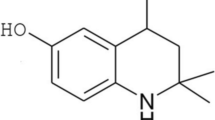Abstract—We studied changes in the indices of free-radical oxidation and thiol-disulfide status in the brain structures in the experimental model of Parkinson’s disease (PD) induced by administration of rotenone to rats. Pantothenic acid derivatives, such as panthenol (PL), pantethine (PT), and homopantothenic acid (HPA) were used as neuromodulators. It was found that redox imbalance in the brain induced by rotenone is accompanied by the activation of free-radical processes, pronounced inhibition of antioxidant defense, a considerable decrease in the glutathione system reduction potential, and increased protein glutathionylation. The strongest changes were in the basal ganglia of the brain. PL and PT but not HPA, decrease the changes in the free-radical oxidation and thiol-disulfide balance in the brain structures. During experimental neurotoxicosis, the mechanisms of neuroprotective action of PL and PT, which are linked with the changes in the biosynthesis of CoA, are, obviously, related to their ability to increase the reduction potential of the glutathione system, thus mitigating the effects of oxidative stress.
Similar content being viewed by others
REFERENCES
Miller, R.L., James-Kracke, M., Sun, G.Y., and Sun, A.Y., Neurochem. Res., 2009, vol. 34, pp. C. 55–65.
Sofic, E., Lange, K.W., Jellinger, K., and Riederer, P., Neurosci. Let., 1992, vol. 142, pp. 128–130.
Gu, F. and Chauhan, V., Curr. Opin. Clin. Nutr. Metab. Care, 2015, vol. 18, pp. 89–95.
Aoyama, K. and Nakaki, T., Internat. J. Mol. Sci., 2013, vol. 14, no. 10, pp. 21021–21044.
McBean, G.J., Mutay, Aslan., Griffiths, H.R., and Torrao, R.C., Redox Biol., 2015, vol. 5, pp. 186–194.
McBean, G.L., Lopez, M.G., and Wallner, F.K., British J. Pharm., 2017, vol. 174, pp. 1750–1770.
Gitler, A.D., Dhillon, P., and Shorter, J., Dis. Models Mech., 2017, vol. 10, pp. 499–502.
Johnson, W.M., Wilson-Delfosse, A.L., and Mieyal, J.J., Nutrients, 2012, vol. 4, pp. 1399–1440.
Schulz, J.B., Lindenau, J., Seyfried, J., and Dichgans, J., Eur. J. Biochem., 2000, vol. 267, no. 16, pp. 4904–4911.
Bashun, N., Kanunnikova, N., Semenovich, D.S., Raduta, E., and Lis, R., German Science Herald, 2017, no. 1, pp. 13–18.
Chung, K.K., Dawson, V.L., and Dawson, T.M., Methods Enzymol., 2005, vol. 396, pp. 139–150.
Melo, A., Monteiro, L., Lima, R.M.F., de Oliveira, D.M., de Cerqueira, M.D., and El-Bacha, R.S., Oxid. Med. Cell. Longev., 2011, vol. 2011, p. 467180.
Semenovich, D.S., Kanunnikova, N.P., and Moiseenok, A.G., Doklady NAN Belarusi, Ser. Med.,
Zhang, Z.N., Zhang, J.S., Xiang, J., Yu, Zh.H., Zhang, W., Cai, M., Li, X.T., Wu, T., Li, W.W., and Cai, D.F., Brain Res., 2017, no. 1655, pp. 104–113.
Erel, O., Clin. Biochem., 2004, vol. 37, pp. 277–285.
Hermes-Lima, M., Willmore, W.G., and Storey, K.B., Free Rad. Biol. Med., 1995, vol. 19, no. 3, pp. 271–280.
Mihara, M. and Uchiyama, M., Anal. Biochem., 1978, vol. 86, no. 1, pp. 271–278.
Durfinova, M., Brechtlova, M., Liska, B., and Baroskova, Z., Chemical Papers, 2007, vol. 61, no. 4, pp. 321–325.
Robyt, J.F., Ackerman, R.J., and Chittenden, C.G., Arch. Biochem. Biophys., 1971, vol. 147, pp. 262–269.
Patsoukis, N. and Georgiou, C.D., Anal. Bioanal. Chem., 2004, vol. 378, pp. 1783–1792.
Anderson, M.E., Methods Enzymol., 1985, vol. 113, pp. 548–555.
Rahman, I., Kode, A., and Biswas, S.K., Nat. Protoc., 2006, vol. 1, no. 6, pp. 3159–3165.
Flohe, L. and Gunzler, W.A., Methods Enzymol., 1984, vol. 105, pp. 114–121.
Habig, W.H., Pabst, M.J., and Jakoby, W.B., J. Biol. Chem., 1974, vol. 249, no. 22, pp. 7130–7139.
Smith, I.K., Vierheller, T.L., and Thorne, C.A., Anal. Biochem., 1988, vol. 175, pp. 408–413.
Menon, D. and Board, P.G., Anal. Biochem., 2013, vol. 433, pp. 132–136.
Garrido, M., Tereshchenko, Y., Zhevtsova, Z., and Taschenberger, G., Acta Neuropathol., 2011, vol. 121, pp. 475–485.
Moiseenok, A.G., Komar, V.I., Khomich, T.I., Kanunnikova, N.P., and Slyshenkov, V.S., Biofactors, 2000, vol. 1, pp. 53–55.
Onufriev, M.V., Stepanichev, M.Yu., Lazareva, N.V., Katkovskaya, I.N., Tishkina, A.O., Moiseenok, A.G., and Gulyaeva, N.V., Neurochem. J., 2010, vol. 4, no. 2, pp. 148–152.
Kanunnikova, N.P., Bashun, N.Z., and Moiseenok, A.G., Lipid Peroxidation, 2012, vol. 23, pp. 492–513.
Ismail, N., Kureishy, N., Church, S., Scholefield, M., Unwin, R.D., Xu, J., Patassini, S., and Cooper, G.J.S., Biochem. Biophys. Res. Commun., vol. 522, no. 1, pp. 220–225.
Kanunnikova, N.P., Semenovich, D.C., Gurinovich, V.A., and Moiseenok, A.G., in Biokhimiya i molekulyarnaya biologiya. Vyp. 3. Mekhanizmy regulyatsii protsessov zhiznedeyatel’nosti v norme i patologii. Sb. nauch. trudov (Biochemistry and Molecular Biology. Issue 3. Mechanisms of Regulation of Vital Activity in Norm and Pathology. Sb. Nauch. Tr.), Minsk: IVTs Minfina, 2019, pp. 64–67.
Funding
The work was supported by grant 1.64 SSRP of the Republic of Belarus “Biotechnologies,” 2016–2020.
Author information
Authors and Affiliations
Corresponding author
Ethics declarations
Conflict of interest. The authors declare no conflict of interests.
Ethical approval. All the experiments with animals were conducted in compliance with ethical standards and rules on the use of experimental animals in scientific research composed on the basis of Directive 2010/63/EU of the European Parliament and of the Council of September 22, 2010.
Rights and permissions
About this article
Cite this article
Semenovich, D.S., Lukienko, E.P. & Kanunnikova, N.P. Modulating Oxidative Stress Indices and Thiol-Disulfide Balance in the Brain Structures by Pantothenic Acid Derivatives in an Experimental Model of Parkinson’s Disease. Neurochem. J. 15, 24–29 (2021). https://doi.org/10.1134/S1819712421010128
Received:
Revised:
Accepted:
Published:
Issue Date:
DOI: https://doi.org/10.1134/S1819712421010128




